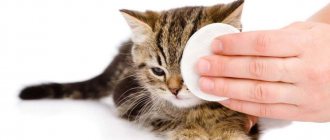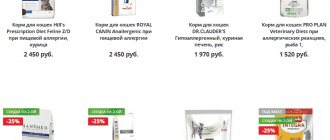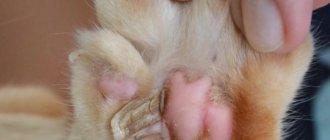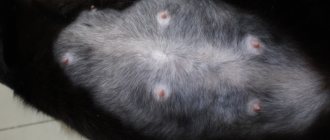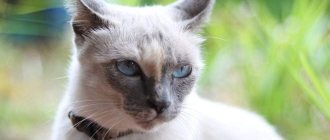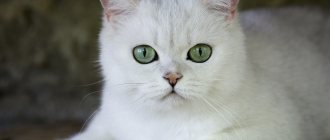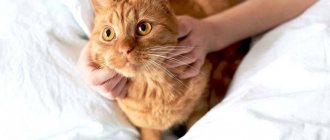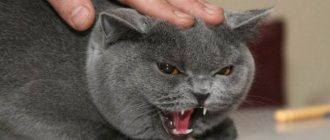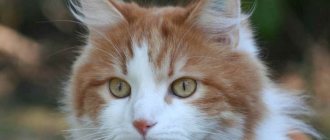Nikolaeva A.: “Do cats have teeth pain and how to find out?”
Inflammatory diseases in the cat’s oral cavity not only cause considerable discomfort, but also pose a serious danger to all organs and systems of the body without exception, interfere with the normal course of metabolism, and reduce immunity.
For this reason, every owner should know how to properly and timely perform dental hygiene and what symptoms should promptly contact a veterinary clinic.
If a cat has toothache, the symptoms of this phenomenon are easy to notice.
- First of all, you need to pay attention to the pet’s behavior, in particular how it eats. As a rule, the cat eats little and slowly, chews carefully, and drops pieces of food.
- In some cases, the cat may even refuse not only the usual treats, but also food. You can often see how your pet freezes in one position with its mouth open, and its salivation increases.
- Experiencing unpleasant sensations, the cat begins to rub its cheeks on furniture or any other surface, scratches its muzzle with its paw, and meows pitifully.
- Upon examination, you can find that the cat’s gums are red and inflamed, an unpleasant putrid odor is felt from the mouth, and the teeth change color. She perceives any attempt to examine the oral cavity as aggressive.
At the first symptoms of toothache, the cat should be taken to a veterinary clinic or, in order not to injure the animal, call a veterinarian at home. After making a diagnosis, the veterinarian will prescribe the appropriate treatment for the pet, which must be strictly followed.
Remember that under no circumstances should you self-medicate!
As a preventive measure, it is recommended to brush your cat’s teeth once every seven days and clean the enamel of plaque.
Symptoms and methods of treating dental diseases in cats
Inflammation processes in the oral cavity in cats negatively affect the entire functioning of the body. The process of chewing and further digestion of food deteriorates significantly, the body's defenses are weakened, and the load on the heart muscle increases.
A responsible, attentive cat owner should be aware of the number of teeth in the pet's mouth, know how to properly care for the pet's oral cavity, and also know when to seek advice from a veterinarian.
The cat's dental system is represented by the following types of teeth: 12 incisors, 4 canines and 14 premolars. The period of replacement of milk teeth with permanent teeth ends on average by the age of eight months. It is important to note that if, when the cat reaches 12 months of age, it has not had a complete replacement of its teeth, the animal will suffer. Congenital anomaly of dental development - oligodontia, has a genetic predisposition, transmitted through generations. Such animals are discarded during breed selection and breeding.
Causes of dental disease in cats
Dental diseases in veterinary medicine have their own classification and vary in severity. There are a number of factors that negatively affect the normal physiological development of teeth in a cat. The main ones are:
- incorrect position of a row of teeth;
- dietary disorders;
- infectious diseases;
- lack of timely veterinary care for injuries and other pathologies developing in the cat’s oral cavity;
- changes in the qualitative composition of saliva and the ratio of beneficial and pathogenic microflora in the animal’s mouth (as a result, there is a risk of developing dangerous diseases);
- factor of genetic heredity (a number of cat breeds have been identified that have a predisposition to dental diseases).
Taking into account all these main factors, it is recommended to carefully carry out hygienic procedures for the cat’s oral cavity and monitor the diet so that non-soft food predominates in it. Cats with a genetic predisposition need to undergo preventive examinations by veterinarians once every six months.
Find out also about stomatitis in cats >>>
Additional reasons
Finally, dental problems are often caused by infectious diseases that, at first glance, have nothing to do with teeth. Particularly dangerous pathogens include the feline immunodeficiency virus (FIV), as well as the virus that causes feline leukemia (FeLV). Calicivirus is also dangerous for your cat's teeth . All these diseases lead to a serious “drawdown” of the immune system, as a result of which the pet’s body cannot normally resist bacteria. This in turn activates pathogenic microorganisms in the animal’s oral cavity. As a result, there is a significantly increased risk of developing caries and similar diseases.
And finally – again about diet. More precisely, about feeding kittens. In practice, it has been proven that kittens who, at the age of six months to a year, did not receive a complete and balanced diet (in terms of nutrients and microelements) are 60% more likely to develop diseases of the oral cavity and teeth. In general, just like with people, if a person suffered from the condition of baby teeth, then by the age of 40 he obviously won’t have a single intact tooth left. So you should take care of your pet’s health, starting from a very young age. Otherwise, you risk spending a lot of time and nerves constantly making visits to the veterinarian.
Symptoms of toothache in cats
The cause of dental disease in cats is a large number of external environmental factors and internal pathologies. Any attentive owner can notice the appearance of characteristic signs of problems in a pet’s teeth or gums. To do this, it is not necessary to look into the animal’s mouth. The main symptoms of the development of diseases in the oral cavity are:
- pronounced rubbing of the muzzle against furniture and things, while the animal does not show pleasure;
- the appearance of a repulsive odor from the mouth;
- gum hyperemia;
- discoloration of tooth enamel;
- display of aggression when the owner tries to look into the mouth;
- refusal to eat due to pain;
- increased secretion of salivary fluid.
Gingivitis in cats
This disease means inflammation, bleeding of the gums, the appearance of cracks and ulcers. It is often accompanied by excessive salivation and a repulsive odor from the mouth.
Therapy involves removing plaque and stones from teeth. For this purpose, special products are used - ointments and gels, which are applied to the surface of the gums (Zubastic, Metrogyl Denta, Dentavedin).
Prevention of gingivitis involves regular care - brushing teeth using cat toothbrushes and toothpastes. It is also useful to give your pet dry food to prevent the formation of deposits on the teeth.
The most common dental diseases in cats
Pathological conditions of the cat's oral cavity are manifested by inflammatory processes in the gums, and also affect the tooth itself. The causes may be tooth decay, for example due to caries, as well as trauma to the muzzle and jaws. The most commonly diagnosed diseases of the teeth and gums are:
- Dental calculus. Dental calculus is a layer with a porous structure. Pathology occurs when there are disturbances in feeding and untimely cleaning of plaque. As a rule, the stone forms in the base area, affecting the root and gum structures. The started process is characterized by complete coverage of the tooth body with a dense layer. resulting from untimely removal of dental plaque. Characteristic signs of the disease are a repulsive odor from the mouth, bleeding and itching in the gum area. The animal tries to make less effort when chewing solid particles of food due to the feeling of discomfort.
- Plaque. A grayish-yellow film formed under the influence of a large number of bacterial microorganisms in the mouth, food residues and salivary fluid. At the first stages, it is not noticeable to the owner and is determined exclusively by a veterinarian using special diagnostic methods. With the development of the pathological process, the film thickens, plaque covers the entire area of the tooth surface and, in the absence of hygienic procedures, turns into tartar. The formation of plaque on a cat’s teeth is determined by both genetic predisposition and an incorrect approach to feeding.
- Caries. The process of decay, as a result of which parts of the tooth, and especially the enamel, are destroyed, forming a through cavity. There are many reasons for the appearance of pathology, but the main ones are a lack of mineral nutrients due to an unbalanced diet or disturbances in metabolic processes in the body. Various mechanical injuries with the formation of a wound surface and infection lead to the penetration of pathogenic bacteria and the development of putrefactive processes in the core of the tooth.
- Odontogenic osteomyelitis. An inflammatory disease that damages the tooth, the soft tissue around it, the alveoli and even the bone marrow. The main cause of dental osteomyelitis in cats is advanced pulpitis, a complication of purulent processes (caries or periodontitis). Odontogenic osteomyelitis is characterized by hyperemia of the gums, pain when chewing food, edema and swelling of the muzzle. Often neglected odontogenic osteomyelitis is accompanied by the development of an abscess, with the further formation of fistulas through which purulent exudate can be released, and regional lymph nodes enlarge.
- Periodontitis. A common disease often diagnosed in the clinical practice of veterinarians. With the development of periodontitis, the upper part of the tooth root is affected. It is diagnosed in cats after two years of age and often becomes chronic. The development of periodontitis occurs when plaque, caries, removal of molars, blows to the crown of the tooth, foreign objects stuck in the gums and not removed in a timely manner are not removed.
- Gingivitis. An inflammatory process of a chronic nature that develops on the mucous membrane of the gums. The primary manifestations of the disease appear as a yellowish coating on the hard part of the tooth. This happens when food particles get stuck between the teeth. The tissue structures begin to become inflamed, hyperemic, bleeding and ulcerative lesions appear on the gums.
- Tooth resorption. Pathology leading to gradual tooth loss and degenerative processes in the tissue structures around them. In veterinary sources, resorption is called odontoblastic resorptive lesion, developing from the gum area, destroying tooth tissue and replacing it with bone tissue. As a rule, premolars are affected, and then other teeth may be damaged. Resorption is not a contagious pathology, but when a tooth is lost, an infection of bacterial or fungal etiology can occur, which leads to purulent tissue lesions.
Symptoms and causes of tooth loss, help and prevention for animals
Animal dentistry in Russia is poorly developed. Therefore, when a cat loses a tooth, owners worry. They are looking for reasons and ways to help their pet. This article examines this issue from all possible angles, talks about the causes and preventive measures.
Milk teeth and their replacement
Kittens are born toothless. In the second week of life, their baby teeth should grow in. The process is completed by 3-4 months. The normal physiological process of replacing baby teeth with permanent teeth begins immediately. By the age of seven months, this process is completed.
Sick cat
During this period, the pet’s oral cavity and gum condition are monitored. An animal is considered adult when it has 30 teeth:
- incisors - fix prey, 12 pieces (equally on the upper and lower jaws);
- fangs - animals use them to kill prey, 4 pieces (one each to the left and right of the incisors on both jaws);
- premolars - small molars, 10 pieces (4 at the top, 6 at the bottom);
- molars - grind food, 4 pieces (equally on each jaw).
Causes of loss of permanent teeth
The cat is drooling: the main causes and treatment options
Proper nutrition and good care guarantee the preservation of the animal's teeth until old age. But, if after a year of life a cat’s teeth fall out, this is evidence of pathology:
Gum inflammation
- Trauma to the soft tissues of the oral cavity - causes inflammation, but is easily treated.
- Stomatitis - the causes have not been studied. Inflammation progresses on the gums, making it painful for the cat to chew and swallow. The mouth may smell and saliva may flow. The animal loses appetite and weight. When the disease is advanced, it turns out that the cat has lost all its front teeth.
- Malocclusion—the lower jaws are not aligned correctly with the upper jaws. In clinics, pathological occlusion is corrected; it leads to tooth loss and disease. The aesthetic side is not taken into account.
- Lack of vitamins and minerals. Poor nutrition leads to vitamin deficiency, weak gums, and tooth loss.
- Tartar. The reason why a cat accidentally lost a tooth may lie in soft food from the owner’s table. Such food settles on the teeth, gradually becomes cemented, and tartar forms.
Oncological diseases, intestinal infections, antibiotics and hormonal drugs, old age. These are the reasons that explain why a cat's permanent teeth fall out.
Information: Tartar often forms in old, weakened and sick individuals.
Symptoms accompanying tooth loss
Cat harness: main types and DIY options
When the problem is detected at an early stage, treatment is successful. Owners monitor the behavior of their pets in order to notice the symptoms of dental disease in cats in time and begin treatment.
At the veterinarian's appointment
Signs of the disease:
- It hurts the cat to chew. She refuses to eat or chews carefully so as not to touch the sore spot.
- Becomes aggressive and irritable. Bites and scratches its owner. Meows anxiously.
- He rubs his face with his paw, washes himself, shakes his head - perhaps the cat’s fang has fallen out.
- Sits with his mouth open.
The owner must examine the gums and tongue. If there are abscesses and bumps on the jaws, there is an unpleasant odor from the mouth - these are symptoms of diseased incisors.
Saliva flows profusely, the gums are swollen and red. Blood and pus from the mouth are a reason to seek medical help.
When an old cat’s teeth are loose, they don’t think twice about what to do - go to the veterinarian. The clinic relieves suffering for older animals.
Important! Dental problems begin gradually. An attentive owner notices the symptoms in time. Treatment in the initial stages of the disease keeps the cat healthy.
Ways to solve dental problems
How to brush a cat's teeth: options at home
Pets can have caries and gingivitis, as well as osteomyelitis and periodontitis. At first they all look like caries: the enamel is destroyed. Therefore, only a good veterinarian can accurately diagnose the problem.
Regular caries goes through several stages before a cat's gums become inflamed. Pain appears precisely from this, already in the later stages.
A sign of caries is a white spot on a canine or premolar. At this point, the owner can still help the cat. The stain is treated with hydrogen peroxide, and the mouth is washed with herbal infusions.
When they can’t help, they go to the vet. The dentist has special cauterizing agents in his arsenal. If they do not help, or the disease is advanced, the diseased element is removed. The operation is performed under full anesthesia, and the wound is sutured.
For several days after this, the animal is given painkillers.
Problems are solved using other, less drastic, methods:
- Organize proper nutrition. You need to feed your cat moderately soft food, but with layered solid inclusions. This provides the necessary load on the gums.
- They use drugs to strengthen teeth: antibiotics, antiseptics. When infections are eliminated, inflammation does not occur in the oral cavity, which leads to dental diseases.
- Strengthen the gums with ointments Metrogyl Denta, Dentavidin. The drug Zubastik helps a lot.
- They give vitamins and immune support products. Which ones are determined by the veterinarian after examining the animal. A weak immune system and lack of vitamins and minerals in the diet lead to weakened gums. They bleed and become breeding grounds for bacteria and germs.
- Strengthen teeth with nutrition: Denta-Kiss Gimpet (2-4 tablets daily), Beafar crispy pads (5-6 pieces per day), Happy cat cookies.
Tartar removal
Tartar causes pain and tooth loss. Fangs are most often affected. Owners of four-legged pets should know what to do when a cat's fang falls out and how to prevent the loss of other teeth.
The stone is removed independently:
- Can be treated with hydrogen peroxide. Moisten the gauze and clean the problem area. Rinse your mouth with a decoction of herbs.
- They are given toothpick toys to chew on.
- Use a silicone brush - put it on your finger and clean the sore spot.
- Polish the stone with a cloth soaked in a special solution.
Note! When they can’t cope, they go to the vet. The doctor removes the stone manually or with ultrasound.
Oral hygiene - prevention of dental diseases
Prevention of tooth loss
Preventing the loss of incisors is easier than treating a pet’s diseased chewing apparatus:
- Diet. Canned food does not clean tooth enamel. A plaque appears. Therefore, they give food with solid particles, rich in vitamins and minerals.
- Oral hygiene. Brush your teeth with a soft brush with a paste that tastes and smells like meat. This needs to be done as a daily procedure.
- Show it to the vet. He detects the problem, helps, and gives recommendations.
- Treat gum diseases. Strengthening herbal decoctions, gels, and ointments are used.
Pets suffer from toothache when the owners are not attentive enough to them: they do not notice injuries to the oral cavity, they neglect hygiene. Eating only soft canned food leads to the formation of plaque, and subsequently forms tartar. Lack of vitamins, weakened immunity, infections are the causes of dental problems.
The first signs of the disease - drooling, bleeding gums, unpleasant odor from the mouth - are a reason to consult a doctor. A good owner does not put off visiting the veterinarian and tries to cure his animal as quickly as possible.
Source: https://gafki.ru/koshki/vypal-zub.html
Treatment of dental disease in cats
As a result of what has become the leading cause of dental disease in cats, the veterinarian selects individual treatment suitable exclusively for a particular animal.
If the cause of a cat’s dental problems is tartar, therapy is based on its complete removal. The optimal method of cleaning damaged tissue is selected, based on the severity and neglect of the degenerative process.
In the first stages of tartar formation, it is possible to eliminate it with the help of special gels or ointments. Advanced cases of plaque and tartar require anesthesia and removal of growths using ultrasonic equipment or a chisel.
Treatment for spotty and superficial caries involves treating the affected tooth with a special solution of sodium fluoride or silver nitrate. It is quite problematic to give a pet a full-fledged filling, so in the vast majority of cases of advanced caries, they are treated by removing the diseased tooth.
The initial stages of osteomyelitis can be treated with broad-spectrum antibiotics, sulfonamide medications and immunomodulatory drugs. More advanced cases of the development of dental osteomyelitis include surgical intervention under local or general anesthesia, opening of the resulting fistula, removal of purulent contents from the cavity and treatment with special antibacterial solutions.
Periodontitis can be treated by spraying the cat's mouth with disinfectant solutions. In the affected area, the tooth is treated with iodine-glycerin or a 5% alum solution. Treatment for gingivitis depends directly on the stage of neglect of the pathological process. Sick animals must undergo daily cleaning and treat the affected gums with medicinal ointments. Advanced cases require antimicrobial and hormonal therapy.
Prevention of disease development
In the wild, representatives of the cat family clean their teeth through mechanical action. Being a predator, wild cats eat cartilage and raw meat, and also live less than their domestic relatives.
Domestic cats manage to wear down their teeth throughout their lives; the load on the teeth is enormous, resulting in the formation of microcracks into which pathogenic bacterial microorganisms easily penetrate. This is what causes the formation of tartar, caries, osteomyelitis and other diseases.
Cat owners don't often think about taking good care of their pet's oral cavity, but in fact it is necessary. It is important to regularly inspect your pet's mouth to remove any stuck food particles. If there are minor changes in your pet’s gums or teeth, do not delay a visit to the veterinarian.
Proper organization of cat nutrition deserves special attention. It is necessary to take care of a balanced diet, selecting super-premium brands of food, periodically adding a line to prevent dental disease.
Causes of dental diseases
So, reason number 1 is poor nutrition. If your pet sees only liquid food in his bowl day after day, you can rest assured that he will quickly develop dental problems. Usually. This happens due to the fact that when consuming liquid nutrition, the jaws practically do not work for their intended purpose. Plaque settles on the teeth, which is not cleaned, and over time turns into tartar. The formation of tartar leads to serious consequences, such as periodontitis or stomatitis. In nature, wild cats have the opportunity to clean their teeth of plaque using solid food - chewing bones and cartilage.
Reason number 2 is natural aging. As you know, indoor cats live twice as long as street cats, so they often experience aging and destruction of tooth enamel. As a result, teeth deteriorate and may fall out or be completely destroyed.
Reason 3 – heredity. It is likely that teeth can deteriorate due to many hereditary or breed-specific diseases.
Reason 4 – caries. Yes, yes, cats suffer from it too. Caries in cats can appear as a result of jaw injury or various disorders accompanying changes in the functioning of the salivary glands or metabolism.
Dental diseases in cats: symptoms and treatment
The domestic cat, no matter how affectionate and playful it is, is, first of all, still a predator with well-developed fangs, which are designed for successful hunting. At the same time, dental diseases in cats can provoke many problems with the health of the whole body: the digestive organs (intestines and stomach) suffer, the immune system weakens. It is for this reason that caring owners of furry pets should closely monitor the cat’s oral health.
Dental diseases in cats
A little about treatment
We emphasize once again that all dental procedures in cats should be carried out exclusively under general or high-quality local anesthesia. It is quite possible that otherwise the cat will seriously suffer from severe painful shock or injure itself trying to free itself from the fixing devices.
You also need to understand that veterinary dentistry (in our country, at least) is rather poorly developed, and therefore more often it is necessary not to treat the tooth, but to remove it immediately. However, cat owners in more “advanced” countries in terms of veterinary medicine share the same opinion, since the cost of dental treatment for animals is very high.
Cats with dental diseases quite often develop complications in the form of abscesses and septic phenomena , and therefore blood tests are required. In addition, painkillers are prescribed and medications are administered intravenously to relieve intoxication. If the equipment and resources of the owner allow, the installation of prostheses is occasionally practiced.
It is better to prevent dental diseases in cats right away - with good nutrition, regular cleaning, etc., since their consequences are painful both for the breeder’s pocket and for the health of the animal.
Cat's dental system
Dental diseases at the primary stage of their development are quite difficult to diagnose. However, understanding what the normal structure of a cat’s dental system should be will help you notice the problem in time and immediately begin treatment measures, thereby avoiding complications.
Important! The occurrence of any disorders in the oral cavity may indicate the onset of an inflammatory process caused by infection or the proliferation of pathogenic bacteria.
Baby teeth erupt in newborn kittens a few weeks after they are born. After 6-7 weeks, they begin to give way to permanent ones: this stage is normally virtually invisible, but in some individual cases it can cause significant discomfort to the animal. At this time, the cat’s body produces a special substance - lysozyme, which helps stop the development of infection, providing an antimicrobial effect. An insufficient amount of lysozyme can provoke a disruption of the bacterial background, which will provoke the occurrence of tartar and caries.
A healthy domestic cat normally has 30 teeth - 16 on the upper jaw and 14 on the lower:
- Incisors. Small teeth located in front on both jaws, 6 pieces each. The animal does not use them for chewing food - they serve to fix prey in the mouth or hold large pieces of food.
- Fangs. The longest and sharpest teeth are used by wild animals to kill their prey. The canines are quite powerful because they have the deepest root canals. On the jaws of cats there is one fang on both sides.
- Premolars. Small molars are suitable for grinding food, particularly meat. All cats have six upper and four lower premolars with roots of different lengths.
- Molars. Also designed for grinding food.
The structure of the cat's dental system
All teeth in cats, like in humans, are theoretically susceptible to mechanical damage, for example, when a tooth breaks due to a head injury or as a result of a strong blow. However, most often, pathologies of the dental system in cats have the following causes:
- Genetic failure. Often, defects in the structure of the oral cavity and an inherent hereditary factor of predisposition to diseases are found in selective breeds of cats.
- Pathologies of bite and enamel. In some breeds, several permanent teeth are missing from birth, which leads to accelerated wear of the remaining teeth and thinning of the enamel.
- Ecology - the influence of chemicals and carcinogens in air, water and food.
- Infections that can cause abscesses leading to tooth loss.
- Lack of oral hygiene. If the owner does not promptly eliminate plaque on his pet’s teeth, its layer is transformed into hard tartar, which can damage the gums and lead to the appearance of even more serious pathologies.
Types of malocclusion
Since there are many causes of dental disease in cats, it is advisable for the owner to closely monitor his pet in order to notice the problem at the initial stage of its development. The most common signs of dental disease in cats are:
- red, sore, or swollen gums;
- the presence of an abscess or lump on the animal’s jaw;
- pungent and unpleasant odor from the mouth;
- loose or worn down teeth;
- increased salivation.
Attention! It is important to remember that the symptoms of dental diseases usually appear gradually, so attentive owners always have a chance to notice the pathology in time and begin treatment, preventing the development of the disease.
At the same time, the animal’s reaction to toothache is practically no different from the human reaction:
- It becomes painful for the animal to chew, especially in the area of the affected tooth. If the pain is very severe, the cat may refuse to eat altogether. You can easily notice that she is trying to chew so as not to touch the sore tooth.
- The cat's behavior changes: it becomes irritated, aggressive, and is capable of scratching or biting its owner, especially when trying to pick it up and examine its mouth.
- The animal constantly rubs its face with its paw, washes itself or persistently rubs its cheek on hard surfaces, meows, and behaves restlessly.
Causes and symptoms of toothache
Diseases of the dental system in cats are extremely diverse, and they can have different causes and clinical presentations. However, all such pathologies lead to significant health problems, so the owner should constantly monitor the oral health of their pet.
Table. Dental diseases in cats
| Disease | Causes | Treatment | Phytotherapy |
| Tartar | Hard plaque on teeth that provokes inflammation after a certain time | Carried out using a painless ultrasonic cleaning procedure | Rinsing the cat's mouth with a solution of baking soda (1 liter of clean boiled water, a few tablespoons of soda and 5-6 drops of iodine solution). Use 2-3 times a day for 5 days |
| Caries | Tooth decay caused by pathological processes in its hard tissues | Under the supervision of a specialist, depending on the severity of the disease and the number of affected teeth | Irrigate the animal's mouth with tincture of sea buckthorn or anise, a strong decoction of chamomile or St. John's wort (1 liter of clean water for 2-3 tablespoons, leave overnight). Repeat the procedure 1-2 times for 3-5 days |
| Periodontitis | Inflammation of tissue at the tooth root | Spraying or rinsing the mouth with antiseptic preparations | Treatment of the mucous membranes of the mouth and teeth with furatsilin or manganese solution (2-3 drops per glass of water). Repeat twice a day for 3 days in a row |
| Osteomyelitis | Inflammation in the gums | A course of antibiotics is prescribed | Rinsing the mouth with a weak solution of potassium permanganate once a day for 3 days |
| Gingivitis | Inflammatory process on the mucous membrane lining the cat's oral cavity | Conducted exclusively under the supervision of a doctor, involves the prescription of medications and procedures | Irrigate your pet's mouth with a decoction of oak bark, mint leaves, raspberries and chamomile flowers (2-3 tablespoons of the mixture per liter of water). Rinse for 3-5 days, 2 times a day. |
Plaque and stones on teeth
Plaque begins to form immediately after the appearance of permanent teeth in cats. First, an invisible film forms on the enamel, then it turns yellow and covers the entire tooth.
Tartar in cats
Tartar is a crystalline, dark-colored salt deposit. It often causes a distinctly strong stench from a cat’s mouth, loosening of fangs and incisors, and the development of other dental diseases.
Reference! Tartar often forms in old, weakened or sick cats, but sometimes dense plaque also occurs in apparently strong pets.
The stone is formed in those areas that are washed more than others by saliva - first on the sides of the incisors and fangs, then on the inner or outer plane of the molars near the gums. A hereditary tendency to the rapid spread of tartar is present in Siamese, Persian and Abyssinian cat breeds. If plaque can be eliminated by a cat on its own, then treatment of stones should only be carried out under the guidance of a specialist. Most often, ultrasonic cleaning is used to remove stones.
Video - How to brush a cat's teeth?
Dental caries
Caries is characterized by decay of the bone tissue of the tooth, after which the tooth enamel is destroyed and voids appear in its cavity. The onset of the disease can be noticed by a change in the color of the gums near one or a pair of teeth. Then, after a certain time, a swelling appears at the level of the lesion, which is clearly visible externally. Without urgent treatment, there is a possibility of developing abscesses and purulent fistulas.
Treatment of caries will be directly related to the form of development of the disease. In veterinary medicine, it is practiced to stop the source of spread with silver nitrate or sodium fluoride. If the caries is advanced, the tooth often needs to be removed.
Periodontitis of teeth
Periodontitis is considered a fairly serious disease that can lead to significant consequences. Most often, it begins after several years of active plaque formation and, without timely treatment, leads to loss of the damaged tooth.
Periodontitis is considered a fairly serious disease that can lead to significant consequences.
Important! Unlike gingivitis, which appears in a cat after two years of life, periodontitis occurs in pets at 4-5 years of age. Without proper treatment, it can cause tooth loss.
The disease is acute, purulent, aseptic or chronic. Typical signs of the development of periodontitis are considered to be:
- looseness of one or two teeth;
- swelling of the gums (with purulent form);
- lack of appetite in the cat;
- foul odor from an animal's mouth.
Treatment of periodontitis involves therapy under the supervision of a specialist. Among the therapeutic agents, “Yoddicerin” is used, which is used to lubricate the gums around the affected tooth.
Osteomyelitis of teeth
Osteomyelitis of teeth in a cat
Odontogenic osteomyelitis is an inflammation that is often a complication in the presence of caries, periodontitis or pulpitis. Due to the presence of infection or caries, a cavity filled with pus can form on the gum. After some time, this cavity bursts, and pus begins to ooze into the oral cavity. In addition, this pathology is often accompanied by the rapid formation of plaque, since due to tooth pain it is very difficult to clean the cat’s mouth. Symptoms of osteomyelitis are:
- redness of the gums;
- compacted swelling at the level of the source of inflammation, clearly visible upon examination;
- development of an abscess in the periosteum area;
- formation of a fistula with pus;
- enlarged lymph nodes.
Treatment of osteomyelitis involves contacting a qualified specialist. Antibiotics are often prescribed taking into account sensitivity determination by bacterial culture, including sulfonamides.
Gingivitis of teeth
Dental gingivitis in cats
Gingivitis is an inflammation of the oral mucosa, which is often accompanied by the appearance of ulcers on the gums. Most often, gingivitis in cats occurs when the oral mucosa is damaged by sharp bones from fish or chicken, as well as during the change of baby teeth. In older cats, it can develop during the spread of caries or with significant deposits of tartar.
Attention! Gingivitis often means the presence of other acute diseases of organs or systems.
Severe symptoms include increased salivation, thirst, and abscess of the oral mucosa. Inflamed gums usually take on a purple, reddish or deep burgundy hue. As the disease progresses, bleeding ulcers often occur.
Treatment of the disease involves taking medications under the supervision of a specialist. Sometimes you will need broad-spectrum antimicrobial drugs (Tetracycline, effective in the early stages, and Metronidazole).
The drug "Metronidazole"
Treatment of gingivitis in cats - effective methods
Dental diseases are not a rare problem for our smaller friends. The most common tooth and gum disease in cats is gingivitis.
What factors contribute to the development of gingivitis?
Gingivitis is an inflammatory process that develops in the gums, affecting the area around one or more teeth. Gum inflammation is the beginning of a destructive syndrome in the tissues surrounding the bone structure.
The mechanism of action of gingivitis is as follows: first it affects the gums, then the ligaments and bones on which the teeth are attached. According to veterinarians, gingivitis is nothing more than the beginning of a difficult and difficult to treat disease - periodontal disease.
The reasons that provoke the development of gingivitis can be divided into internal (endogenous) and external (exogenous). Internal factors include:
- vitamin deficiency;
- abnormal arrangement of the lower and upper teeth at the moment of closing the jaws (bite);
- hardened plaque;
- caries.
External causes of the disease are considered:
- wounds of the oral cavity caused by tubular bones and other sharp objects;
- radiation received as a result of radiation therapy, x-rays, etc.;
- infections;
- viruses (calcivirus, herpes, etc.);
- exposure to chemical elements.
Gingivitis can occur in any pet, regardless of breed; at risk are animals aged 5 years and older, an unbalanced diet, blood pathologies, and autoimmune diseases.
Main symptoms
An attentive owner can easily identify signs of gingivitis in his pet. The animal becomes lethargic and apathetic, sometimes showing aggression and irritability. A visual examination of the oral cavity shows red, swollen gums. The characteristic clinical picture of gingivitis is incessant drooling mixed with blood.
A foul odor comes from the animal’s mouth, caused by the decomposition of food debris and the activity of pathogenic microorganisms.
The cat feels pain in the gums, due to which it cannot chew or eat. As the disease progresses, he loses a lot of weight and becomes weaker.
If you suspect gingivitis in your four-legged pet, the owner should immediately take the furry cat to the veterinarian. Delay is fraught with the spread of infection throughout the body, damage to the liver, kidneys and other internal organs and systems.
Diagnostics
To confirm or refute the diagnosis of gingivitis, the veterinarian needs to conduct diagnostic tests - x-rays, biopsy, tissue collection for histological analysis.
Sometimes it is necessary to do tests to detect the immunodeficiency virus and leukemia.
Blood and urine tests are not prescribed: these studies are useless for diagnosing gingivitis.
Treatment methods
Severe forms of gingivitis are treated comprehensively. If the pathology was diagnosed at the initial stage, then brushing your teeth will be quite enough. Experts warn: toothpastes intended for humans should not be used.
The concentration of some components in cleaning products is very high and negatively affects the health of the fluffy. In addition, cats do not like the menthol aroma that is present in most formulations.
To clean plaque, a special brush is used, which can be purchased at any veterinary pharmacy. If this is not possible, a regular toothbrush intended for children 3-5 years old will do. The bristles of these brushes are very soft and safe.
Miramistin, Chlorhexidine and other special disinfectant solutions are used to treat the oral cavity. After treatment, the gums are lubricated with “Zubastic” or “Dentavedin” ointments.
In the later stages, medication and sanitation in a veterinary clinic are indicated. The cavity is cleaned using an ultrasonic scaler.
The drug Interferon is effective in the fight against gingivitis. It stops the development of pathology, preventing its transition to severe stages. In addition, the product has a powerful immunostimulating effect.
The drug is well absorbed by animals and belongs to the category of harmless, not causing side effects, including allergies. Despite this, only a veterinarian can prescribe it and set the dosage and duration of treatment.
To treat advanced forms of gingivitis, antibiotics (Lincomycin, Clindamycin, Stomorgyl, Convenia) and immunosuppressants (Prednisolone, Azathioprine, corticosteroids) are used.
Tooth removal is indicated only in the most severe cases, since a toothless cat becomes disabled. But if the veterinarian makes such a decision, it means that there is no other way to eliminate the cause of the disease and the direct source of pathogenic microflora.
With timely and adequate treatment, the prognosis is favorable.
What to do at home
The owner must provide his pet with the most comfortable living conditions and strictly follow the veterinarian’s instructions. You should not self-medicate, as this can aggravate the situation and cause irreparable harm to the cat’s health.
You can alleviate the suffering of a fluffy by using a soda solution or decoctions of medicinal herbs that have a disinfectant and antimicrobial effect. However, traditional methods cannot replace traditional treatment and are used as additional measures.
A decoction of chamomile, oregano, and strawberry leaves has worked well. You need to boil 1 teaspoon of the dried plant, pour a glass of boiling water, and cook over low heat for 10 minutes. Then strain the broth, cool and use to wipe the animal’s mouth.
During gingivitis, a cat usually refuses to eat, since even a small, barely chewed piece causes her pain. However, to defeat pathology, the body needs strength. Your four-legged pet should be fed with special soft food intended for weakened cats, pureed meat and vegetables, meat or chicken broth.
Possible complications
Even mild forms of gingivitis, if not treated correctly, can result in the development of plasmacytic-lymphocytic gingivitis - an ulcerative lesion of the oral mucosa. The danger of the disease is that ulcers form not only on the gums and around the teeth, but also in the larynx and esophagus.
Since the animal cannot eat normally and swallows food whole, disorders of the gastrointestinal tract, metabolic processes, and intestinal blockage cannot be ruled out.
If left untreated, gingivitis progresses to periodontal disease, characterized by tooth decay and loss. The pathology is characterized by severe pain, festering wounds, and ulcers in the oral cavity. In the future, complete destruction of individual parts of the oral cavity can be observed, and in severe cases, jaw fractures.
In addition, advanced gingivitis creates a threat of infection of the body with toxins that arise during the life of pathogenic microorganisms. The body becomes severely poisoned and sepsis develops. Blood poisoning is accompanied by irreversible pathologies of internal organs.
Prevention measures
Almost any disease can be prevented, and gingivitis is no exception. By following simple preventive measures, you can protect your pet from gum inflammation.
Regularly inspect your cat's mouth for wounds, scratches, ulcers, foul odor, and caries. By the way, caries, which can cause gingivitis, is successfully treated by cauterizing carious spots with sodium fluoride and silver nitrate.
When the first signs of gingivitis and other dental diseases appear, contact your veterinary clinic immediately. The sooner treatment begins, the greater the chance of avoiding health consequences.
The best prevention of gingivitis is to prevent the formation of tartar and plaque, through which the gums become infected. Clean your pet's teeth twice a month with special toothpastes.
In order for a cat to perceive brushing his teeth as a normal procedure, he needs to be accustomed to this manipulation from an early age.
Popular pastes include Elgidium, Radiance, and Feline Oral Care. In parallel with this, you can use special chewing toys. Such items not only strengthen and clean teeth, but also satisfy the need to chew.
If plaque has formed, you cannot do anything about it yourself. Tartar removal is carried out in a clinic; if you try to get rid of it yourself, you risk injuring your pet.
Tartar, as a rule, appears due to poor nutrition: cheap dry food of economy class, the predominance of hard foods, lack of vitamins (especially ascorbic acid). Make your cat's menu taking these features into account.
Feed your cat high-quality premium and super premium food from well-known manufacturers. Nutrients and vitamins are in optimal proportions. Twice a year, it is advisable to switch your pet to a special medicated food containing ingredients that effectively cleanse the teeth and oral cavity.
Consult your veterinarian regarding vitamin and mineral supplements. Cats require nutritional supplements fortified with vitamin C and calcium, but it is wrong to give them without consulting a specialist.
Authors of the articles: Belanta Clinic team
Source: https://www.belanta.vet/vet-blog/gingivit-u-koshek/
Factors affecting your cat's dental health
The health of the dental system of cats, like any other mammal, directly depends on several factors. These include past or developing infectious diseases, nutrition, and genetic characteristics in certain breeds.
Anomalies in the development of teeth and bite
If your pet has certain pathologies in the formation of teeth or bite, this can provoke the occurrence of typical problems:
- difficulty grinding solid food;
- injuries of the mouth and mucous membrane;
- the formation of abnormalities of the digestive organs.
Among the anomalies with the development of teeth in cats, experts identify incorrect bite structure and congenital or acquired enamel defects. So, if at the stage of formation of permanent incisors the baby teeth are not eliminated, the permanent teeth may take an incorrect position.
Important! During the formation of tooth enamel in cats, past diseases can also provoke the occurrence of defects in the upper layer of the tooth.
Diet
A diet consisting exclusively of soft canned food does not have a cleansing effect on tooth enamel.
Eating certain foods and following a diet plays an exceptional role in preventing the occurrence of dental diseases in domestic cats. It is important to remember that a diet consisting exclusively of soft canned food does not have a cleansing effect on tooth enamel and can contribute to the rapid formation of plaque. Moreover, this eating pattern encourages food particles to accumulate in the spaces between food pieces on or between teeth, allowing bacteria to spread and plaque to form quickly.
Dry food, on the contrary, due to the need for thorough chewing, has good cleansing properties. In this case, it is necessary to take into account the composition of such canned food, which should include all the necessary minerals, vitamins and nutrients.
Treatment of dental diseases
Often, the owner’s quick response and urgent contact with a qualified doctor contributes to the most optimistic prognosis for the treatment of most dental diseases in pets. If you delay and ignore the problem, there is a significant likelihood of aggravating it, which can cause sepsis to spread to internal organs, blood poisoning, and in rare cases lead to death.
If you suspect a disease, you should immediately consult a doctor
It should be remembered that there is no single method for treating such diseases in animals, as in humans. Therapeutic measures will depend not only on the nature of the pathology that has arisen, but also on the specific causes of its occurrence, as well as symptoms. The specialist is always obliged to take into account all the circumstances of the manifestation of the disease - only after that can he prescribe procedures and recommend medications.
The owner should prepare for the fact that dental disease in his pet often requires drastic measures - removal of the affected tooth, and in some cases, the teeth located near it.
Preventive measures can help prevent health problems for your pet, or at least delay their occurrence for a while. It is important to pay close attention to the animal’s diet and make it a rule to carry out hygiene procedures to cleanse its oral cavity.
As long as plaque remains unhardened, it can be removed without effort. To do this, use a regular toothbrush or soft cloth. It is advisable to accustom your cat to the unpleasant cleaning procedure from childhood, from the period when the first teeth appear.
Important! You should not use toothpaste for people - it is advisable to have products for cleaning cat teeth.
Nutrition must be balanced, complete, with sufficient minerals and vitamins
For prevention purposes, you should make it a rule to periodically rinse your cat’s mouth, especially if even subtle inflammation has occurred. To do this, you need to hold the cat by the chest and press his incisors with your fingers - the animal will open its mouth and you can easily pour the broth from a syringe or pipette.
An important factor in the good condition of a pet’s oral cavity is nutrition, which must be balanced, complete, with a sufficient amount of minerals and vitamins. For prevention purposes, you should also give your cat special vitamins - such supplements are made to strengthen the animal’s bones and teeth.
In order to preserve your beloved pet’s dental health for many years, the owner should adhere to the following recommendations:
- Regularly inspect the animal’s oral cavity and remove any pieces of food stuck in the teeth.
- If even the most minor symptoms are present, promptly carry out therapeutic measures.
- Create a balanced menu for your cat, including meat, fish, cheese, eggs and dairy products (a source of protein and calcium).
Teeth and food
Which are fed with canned food, minced meat and other soft or liquid foods. Tartar forms on the surface of non-functioning teeth, which is the cause of diseases that lead to tooth loss or the need for their removal.
The health of teeth and gums is promoted by feeding your cat large pieces of meat and dry food that need to be gnawed and chewed. All this is not only a good exercise for the teeth and a massage for the gums, reducing the likelihood of dental disease, but also a good workout for the jaws, helping to develop their power.
Prevention measures
It is optimal, of course, to accustom your cat to regular hygiene procedures. Fortunately, today there are all available means: both special brushes and toothpastes (human toothpastes are STRICTLY prohibited from being used for animal oral hygiene, as they may well be toxic to your pet). But, let's be honest, this approach is not always feasible. In this case, your task is to monitor the condition of your animal’s oral cavity and regularly undergo professional examinations. check-ups with your veterinary “pediatrician” and perform necessary dental procedures in a timely manner.
So, your home test, which should become regular:
- Breath. Of course, a cat's mouth shouldn't smell like roses, but the smell shouldn't be unpleasant and/or disgusting. If an abnormally strong unpleasant odor comes from the animal’s mouth, it should be shown to a veterinarian.
- Lips and gums. Pull the cat's head towards you and gently move her lips away, look at her gums. The gums should be firm and pink (NOT white, red, or swollen). The teeth should be clean and free of yellowish plaque, brownish tartar, and no broken or missing teeth.
- Bad signs: excessive drooling, cat scratching the mouth area.
- The cat's teeth are falling out.
- Obvious problems. The animal should absolutely not have: dark red lines along the gums, ulcers on the gums or tongue, or pus.

